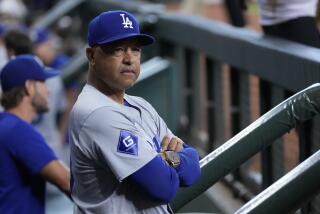MLB teams are in sellers’ market as July 31 trade deadline approaches
- Share via
Reporting from Baltimore — An aging right-hander who has pitched only 40 innings for one of the worst teams in baseball could wind up determining which teams make the World Series this year.
Or maybe that honor will go to a gimpy 34-year-old outfielder with two surgically repaired knees whose current team would pay as much as $6 million to get rid of him.
Then again, maybe neither will get anywhere close to a pennant race. Such are the vagaries of the week before baseball’s July 31 nonwaiver trade deadline, perhaps the busiest and most important seven days of the season.
“It’s always fun,” says Angels General Manager Tony Reagins, who will spend the next week sleeping next to his cellphone. “I look forward to it.”
Last year, more than five dozen players — All-Stars Kerry Wood, Roy Oswalt, Dan Haren, Lance Berkman and Miguel Tejada among them — changed uniforms in the final week of July, several in the final hours.
The pace isn’t likely to be as withering this year since 17 teams entered the weekend within seven games of a postseason berth, making them less likely to trade away valuable pieces that might help another team.
For the other 13, though, it’s a sellers’ market — especially if they have pitching, the most valuable commodity this time of year. Which brings us to Heath Bell, a three-time All-Star with 28 saves who is languishing in the San Diego Padres’ bullpen.
No fewer than eight contending teams figure to make a play for Bell or teammate Mike Adams, with Texas, Philadelphia and St. Louis at the top of that list.
For teams looking to add a bat to the outfield — Philadelphia, Boston, San Francisco and the New York Yankees — the top target is weak-kneed Carlos Beltran, with the New York Mets reportedly willing to pay off his contract for the right deal.
After that, it all becomes a big poker game, says Tampa Bay executive Gerry Hunsicker, who spun major trade-deadline deals during his nine years as general manager of the Houston Astros.
“Sometimes teams want to aggressively move a player and they don’t have a lot of leverage,” Hunsicker says. “Or teams value a player differently. We may have a player we place a certain value on and our trading partner may not agree with that.”
Then again, maybe everybody’s just bluffing.
“A lot of the Internet information … is complete speculation. Some is completely false,” says Reagins, who is clearly a buyer at the trade deadline. “If I have interest in a player, I’m calling the GM and finding out the availability and what the … demand is to get that player.
“You just don’t assume a player is not available.”
Dodgers GM Ned Colletti will be a seller at the trade deadline for the first time in his six years in Los Angeles.
“It’s probably the first time I’ve been with a club that’s been in this position since 1996,” says Colletti, who has been an active buyer in recent summers. “If we can get a prospect or two for someone who’s going to be a free agent, we’d like to do that. What do you call that? Are you a buyer or a seller?”
Colletti says he could be both. He’d like to make a trade that would give him the assets to spin a second deal for a player or players “that would help us the rest of this season and going forward.”
That requires homework and diligence. Colletti relates one deal he was about to make before a scout raised questions after an awkward fielding play the night before. Colletti checked further and found out the player had broken a finger.
“A lot of it is buyer beware,” he says.
Be aware, too, that the trade market doesn’t close when the nonwaiver deadline passes at 1 p.m. PDT on July 31. Teams can still deal players who have cleared waivers — and Hunsicker says most teams dump the majority of their roster on waivers this time of year, hoping to sneak through the ones they’d like to trade.
Which means Reagins will be sleeping with his cellphone for at least a few more weeks.
“We’re looking to improve our club,” he says. “[If] we don’t acquire a player at the trade deadline, there’s still another deadline. If you think you’re forced to make a deal, it probably doesn’t end up very good for you.”
More to Read
Go beyond the scoreboard
Get the latest on L.A.'s teams in the daily Sports Report newsletter.
You may occasionally receive promotional content from the Los Angeles Times.











